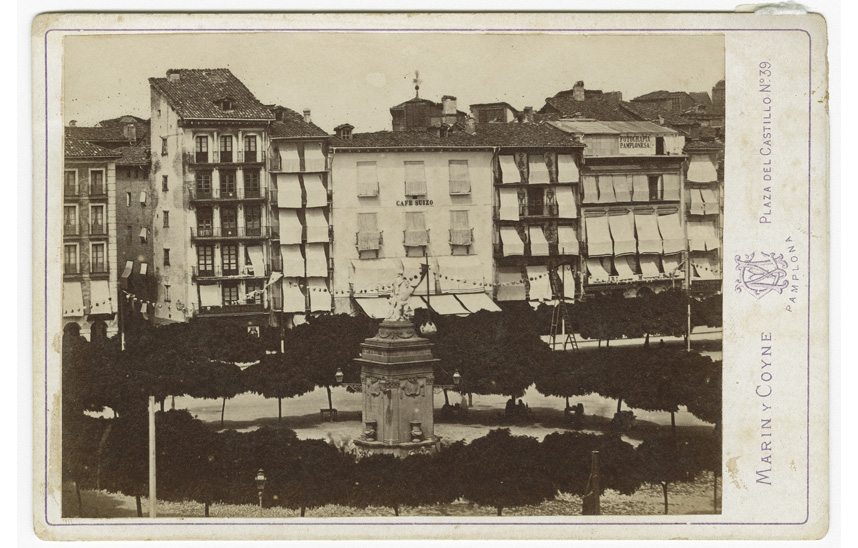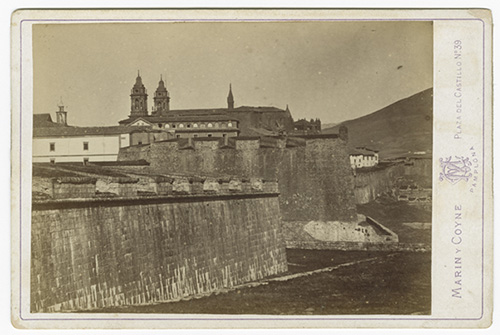Photography and cultural heritage

FotoColecciónJosé Ignacio Riezu Boj/place de la Constitución, today place del Castillo. Marín y Coyné, 1874, carte cabinet
Photography, as a historical-artistic heritage, participates in the duplicity inherent to works of art, with both components of substance and form. It is not only a means of reliable reproduction, but also a means of expression. From this last point of view, it possesses aesthetic qualities that allow its enjoyment and contemplation. It also has historical values that, as Alois Riegl pointed out when referring to the monument, make it a link in the material history of cultural goods.
Photography has been intimately related to the arts and architecture. It constitutes an essential source for art historians, as a historical document that testifies the changes of the goods that make up the cultural heritage, as well as an artistic expression with aesthetic, plastic and technical values.
Along with multiple interests and functions, photography constitutes a documentary source A , a visual record of the first magnitude in a given spatio-temporal context, which is attractive for the study of cultural heritage and for the implementation or study of any conservation and restoration intervention. They are true notarial conference proceedings and windows of visual information, although in some cases they had a clear artistic and creative intention on the part of their author, so they have a true artistic vocation. Photographs, as graphic documents, transcribe "with clarity and definition", in the expression of J. Fontcuberta, images that acquire an extraordinary value by becoming essential tools for the knowledge plenary session of the Executive Council and deep knowledge of an object or a monument, its history, its transformations, the additions or deletions of layers or the interventions suffered over time. However, methodologically, some consider that this speed and cleanliness do not imply reality, as it would rather be a recreated representation, a fortiori, when its author chooses topic, framing and other aspects that speak of his opinion.
If photography, as a historical source and transmitter of visual information, is evident in the study of tangible heritage, it is no less interesting for the knowledge of intangible and anthropological heritage, which, as is well known, includes the manifestations received from their ancestors by groups and communities and transmitted to their descendants, often verbally. Among its aims is the study of oral traditions and expressions, performing arts, social practices, rituals, festive events and traditional craft techniques. Any photograph linked to all this is an essential source for the study of these areas, although it is also necessary to interpret the reason why they were taken, since in some cases they were taken with a clear nostalgic vision of the past.
When analyzing the narrative of these snapshots, whether related to tangible or intangible heritage, we will focus on the study of their details. In this regard, we can recall the reasoning of Valle Inclán, when he wrote about the importance of discovering "the arcane of things that seem vulgar and are marvelous" or the reflection of A. Dumas that "he who reads learns a lot; but he who observes learns more". In the same way that listening is superior to hearing, something similar happens with seeing and looking. To look it is enough to fix our eyes, to see it is necessary to observe, examine and notice, without haste, what appears before our eyes in all its details, which will lead us to understand its message. An old aphorism reminds us that to see we must look and know. After this exercise, we will be able to make a reading of the photographic document, always in its context.

Fort of San Bartolomé, walls of Pamplona and cathedral. Photo Marín y Coyné (1874-1880), carte cabinet. José Ignacio Riezu Boj Collection.
In another scenario that is not the one of this blog, specifically in the digital of Diario de Navarra, we will be presenting, monthly, from March of this year 2023, several photographs -some little known and even unpublished-, belonging to public and private collections. Some of them are of great beauty and generate an enormous visual impact, but many others have no aesthetic intention as a starting point and are of no interest from that point of view, as they suffer from errors of approach, treatment of light and framing. On the other hand, some of them present us with goods that, in many cases, have disappeared or have been substantially altered. Postcards, which enjoyed a great development in the last quarter of the 19th century and a golden age from 1905 until the Civil War, will also be the object of our attention, due to the historical-artistic interest of some of them.
The choice of degree scroll for this series: "Photographs that speak", has to do with the exercise of reading and analyzing the visual information of the different subjects (arguments, in literary terms), always above their mere vision or contemplation.
In all cases they will be accompanied by comments aimed at their contextualization and general reading and their elements that have often disappeared or have been removed for various reasons: fashions, restorations or personal whims. We will try to understand and evaluate what the snapshots offer: objects, typologies, iconographies, interiors and exteriors of buildings, in the light of the precise moment in which the photographer took or captured them, without forgetting historical, anthropological or symbolic aspects inherent to the contents of images that speak per se and respond, multidisciplinary, if asked about their history, use and function, iconography and aesthetics.




